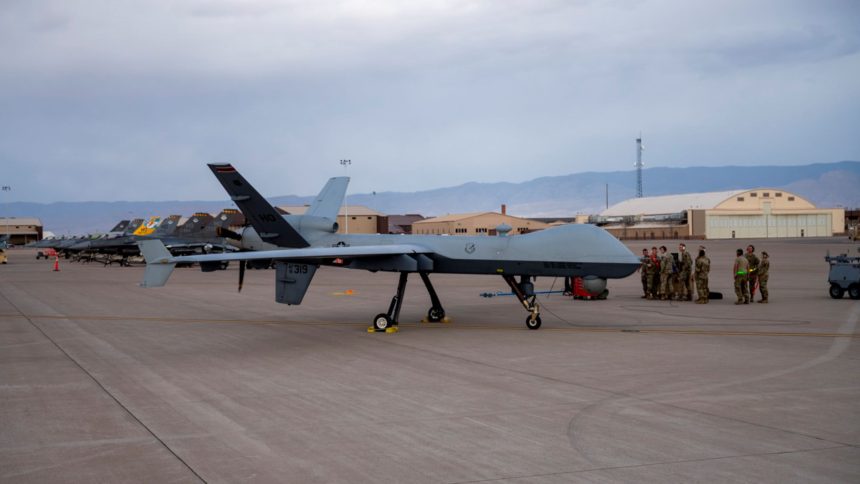Project Iron Agility is a dynamic exercise which sharpens deployment readiness skills through ACE operations with F-16s, MQ-9 Reapers, and integrated logistics support.
The third iteration of the Project Iron Agility exercise at Holloman AFB (Air Force Base), New Mexico, saw unique approaches to refine ACE (Agile Combat Employment) capabilities. These include a table top simulation to envision and plan for unexpected contingencies, increasing the role of the MQ-9 Reaper drones and enhanced interaction between Reaper and F-16 crews for combined operations.
Holloman AFB is home to the 49th Wing, the Air Force’s largest F-16 and MQ-9 FTU (Formal Training Unit). Held for three weeks beginning Mar. 13, 2025, the unique exercise has been increasingly evolving since it was first conceptualized and launched in Aug. 2024 by the AETC (Air Education and Training Command), as images and details released now show.
The deployment exercise was “designed to prepare Airmen for deployment scenarios and enhance their ability to operate in austere environments,” saids the statement. Project Iron Agility’s latest installment was led by the 49th Maintenance Group (MXG), which went beyond simulating deployments and replicated real-world scenarios.
“Adapt, collaborate, and execute quickly—that’s Project Iron Agility.” @HollomanAFB launched its third iteration of its Project Iron Agility exercise; conducted in 3 weeks & 3 phases: academic, planning, and execution.
To dive deeper, learn more here: https://t.co/nWNzjduytz pic.twitter.com/Ced7ocStma
— AETC – First Command (@AETCommand) April 22, 2025
First installment
In its inaugural version at Holloman AFB on Aug. 12, 2024, Project Iron Agility was described as a “strategically crafted training program” to educate senior enlisted leaders and officers in “foundational elements of the United States Air Force Advanced Maintenance and Munitions Operations School (AMMOS) and ACE.”
The exercise was largely academic-oriented, where “knowledge gaps” were identified in interviews with crew chiefs, senior enlisted leaders and officers. This was followed by a week-long program called “Ignite,” which saw instructors from AMMOS training students on “accurately forecasting flying capabilities and effectively managing personnel to facilitate the execution of flying missions.”
Ignite was then succeeded by a three-week program where students were trained to plan and execute for a week-long deployment exercise. “They encountered scenarios that necessitated the transportation of F-16 Fighting Falcons from their home base to a deployment location, ensuring a safe and successful return,” the press release said at the time.
49th Maintenance Group personnel engaged in a realistic deployment scenario as part of a new maintenance training program called Project Iron Agility. It educates SELs and officers in foundational elements of the USAF Advanced Maintenance and Munitions Operations School and ACE. pic.twitter.com/peDavLyq1h
— 49th Wing (@HollomanAFB) September 3, 2024
MQ-9s and F-16s in Project Iron Agility 2025
In its current installment, Project Iron Agility replicated realistic and dynamic situations by emphasizing the “need for rapid adaptation and relocation, a critical capability in modern warfare, ensuring the Air Force can relocate swiftly when necessary.”
The exercise was split into three phases – the academic phase, the planning phase and the execution phase. A major focus was the “seamless integration of both F-16s and MQ-9s,” where “Airmen assigned to one platform actively supported and learned from those working with the other” throughout the execution phase.
“This fostered a culture of collaboration and strengthened the cross-functional nature of the team, aligning perfectly with the ACE concept and highlighting the importance of versatility in modern deployments,” mentioned the statement.
MQ-9s were prepared and pulled from the hangars for the flightline, while F-16Cs were readied with maintenance checks for nighttime operations, images released on the DVIDS network showed. The ISR (Intelligence, Surveillance and Reconnaissance)-focused MQ-9s figured in the drills as both the Reaper and the F-16 are key platforms being involved in ACE operations.
The service says the Reapers “play a key part in a mission that also includes F-16 Fighting Falcons, combining speed, flexibility, and precision.” In fact, “these aircraft provide a unique advantage by operating on smaller runways and offering greater flexibility, making them ideal partners for F-16s.”
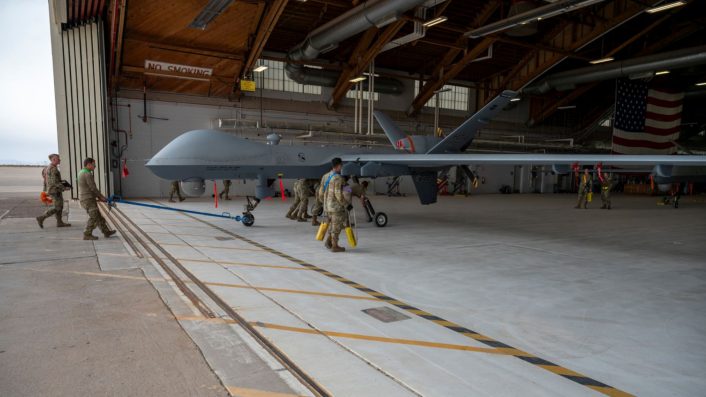
“The MQ-9s are agile and can perform both Intelligence, Surveillance and Reconnaissance and Combat Air Support missions without risking manned aircraft,” said Tech. Sgt. Dalis Harlan, 9th Aircraft Maintenance Unit specialist section chief. “We’re planning for the smallest, most effective footprint, and this exercise combines skills from different Air Force Specialty Codes while streamlining responsibilities so we can adapt quickly if something goes wrong.”
Among the logistics, maintenance and weapons teams, the logistics personnel played a “crucial role,” ranging from “creating supply packages to establishing communications with external units.”
Unlike its STOL (Short Take-Off and Landing) derivative, the Mojave, the Reaper was not designed for ACE (Agile Combat Employment). However, the unmanned aircraft was put to the test logistically to operate from non-paved, austere runways during Exercise Reaper Castillo, held from Nov. 4 to Dec. 18, 2024.
The 65th Special Operations Group and the 1st Special Operations Mission Sustainment Team (SOMST) serviced a Reaper at the Melrose Air Force Range, in New Mexico, off a dirt strip with a small group of maintainers, while it was being controlled from 1,100 miles away at Hurlburt Field, Florida.
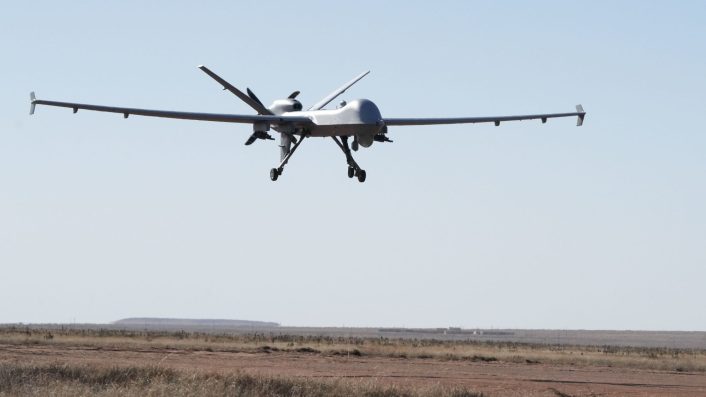
Kingfish ACE simulation tool
The academic phase of the exercise saw the use of the Kingfish ACE simulation, a board game-like tabletop simulation tool which “challenges participants to adapt quickly to changing conditions, mirroring the unpredictability of real combat scenarios.”
This helped “participants apply their learning,” while challenging “players to adapt to rapidly changing conditions, simulating the reallocation of resources and adjusting plans in response to shifting combat scenarios.” The tool also helped maintainers “see how quickly a situation can change and how necessary it is to re-plan and adapt,” by visualizing “asset reallocation and the speed of required adaptation.”
The unpredictability in warfare was similarly practiced in the execution phase, where “real-time injects, or immediate impact drills,” were introduced, requiring the teams to “continuously reassess plans, make decisions collaboratively, conduct rapid risk assessment by replicating the pressures of real-world operations.” This way, “Airmen were challenged to figure out how to maintain critical operations in the face of disruption, reinforcing mission continuity under stress.”
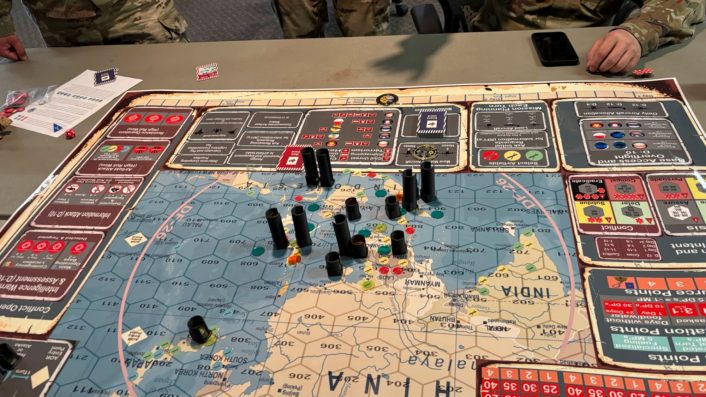
Mission Ready Airmen
Project Iron Agility emphasized the importance of “flexibility and cross-functional roles,” equipping Airmen “to step into various roles as needed, adding depth to their operational expertise and reinforcing agility.”
The latest Project Iron Agility applies “critical thinking to create a bare-bones deployment temporary duty based on a provided organizational structure,” said Tech. Sgt. Michale Smith, 49th LRS fuel service center non-commissioned officer in charge. This “also brings together personnel from a variety of disciplines, including maintenance, logistics, and weapons experts” to work cohesively.
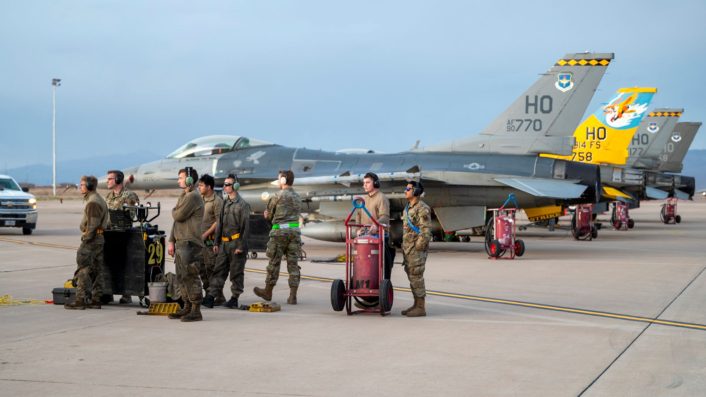
“One minute, we’re flying over a nation, and the next minute, we might not have that airspace anymore,” Harlan explained. “The ability to adapt, collaborate and execute quickly – that’s what Project Iron Agility is all about.”

